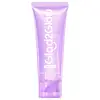What's inside
What's inside
 Key Ingredients
Key Ingredients

 Benefits
Benefits

 Concerns
Concerns

 Ingredients Side-by-side
Ingredients Side-by-side

Water
Skin ConditioningPotassium Cocoyl Glycinate
Acrylates/Steareth-20 Methacrylate Crosspolymer
Sodium Lauroamphoacetate
CleansingVaccinium Angustifolium Fruit Extract
Skin ProtectingPotassium Cocoate
EmulsifyingCeramide EOP
Skin ConditioningCeramide Ng
Skin ConditioningCeramide NP
Skin ConditioningCeramide As
Skin ConditioningCeramide AP
Skin ConditioningSodium Chloride
MaskingGlycosyl Trehalose
Emulsion StabilisingPotassium Hydroxide
BufferingCitric Acid
BufferingHydrogenated Starch Hydrolysate
HumectantLauryl Hydroxysultaine
CleansingCaprylyl Glycol
EmollientDisodium EDTA
Aroma
Phenoxyethanol
PreservativeWater, Potassium Cocoyl Glycinate, Acrylates/Steareth-20 Methacrylate Crosspolymer, Sodium Lauroamphoacetate, Vaccinium Angustifolium Fruit Extract, Potassium Cocoate, Ceramide EOP, Ceramide Ng, Ceramide NP, Ceramide As, Ceramide AP, Sodium Chloride, Glycosyl Trehalose, Potassium Hydroxide, Citric Acid, Hydrogenated Starch Hydrolysate, Lauryl Hydroxysultaine, Caprylyl Glycol, Disodium EDTA, Aroma, Phenoxyethanol
Water
Skin ConditioningAloe Barbadensis Leaf Juice
Skin ConditioningCentella Asiatica Extract
CleansingGlycerin
HumectantAvena Sativa Kernel Extract
AbrasiveSqualane
EmollientBetaine
HumectantCamellia Sinensis Leaf Extract
AntimicrobialCocodimonium Hydroxypropyl Silk Amino Acids
Skin ConditioningSodium Lauroyl Oat Amino Acids
CleansingPanthenol
Skin ConditioningXylitol
HumectantAllantoin
Skin ConditioningCetearyl Alcohol
EmollientCoco-Glucoside
CleansingPhenoxyethanol
PreservativeHyaluronic Acid
HumectantSodium Hyaluronate
HumectantLecithin
EmollientBenzyl Alcohol
PerfumingXanthan Gum
EmulsifyingAcrylates/C10-30 Alkyl Acrylate Crosspolymer
Emulsion StabilisingPolyquaternium-10
Trisodium Ethylenediamine Disuccinate
Water, Aloe Barbadensis Leaf Juice, Centella Asiatica Extract, Glycerin, Avena Sativa Kernel Extract, Squalane, Betaine, Camellia Sinensis Leaf Extract, Cocodimonium Hydroxypropyl Silk Amino Acids, Sodium Lauroyl Oat Amino Acids, Panthenol, Xylitol, Allantoin, Cetearyl Alcohol, Coco-Glucoside, Phenoxyethanol, Hyaluronic Acid, Sodium Hyaluronate, Lecithin, Benzyl Alcohol, Xanthan Gum, Acrylates/C10-30 Alkyl Acrylate Crosspolymer, Polyquaternium-10, Trisodium Ethylenediamine Disuccinate
 Reviews
Reviews

Ingredients Explained
These ingredients are found in both products.
Ingredients higher up in an ingredient list are typically present in a larger amount.
Phenoxyethanol is a preservative that has germicide, antimicrobial, and aromatic properties. Studies show that phenoxyethanol can prevent microbial growth. By itself, it has a scent that is similar to that of a rose.
It's often used in formulations along with Caprylyl Glycol to preserve the shelf life of products.
Water. It's the most common cosmetic ingredient of all. You'll usually see it at the top of ingredient lists, meaning that it makes up the largest part of the product.
So why is it so popular? Water most often acts as a solvent - this means that it helps dissolve other ingredients into the formulation.
You'll also recognize water as that liquid we all need to stay alive. If you see this, drink a glass of water. Stay hydrated!
Learn more about Water